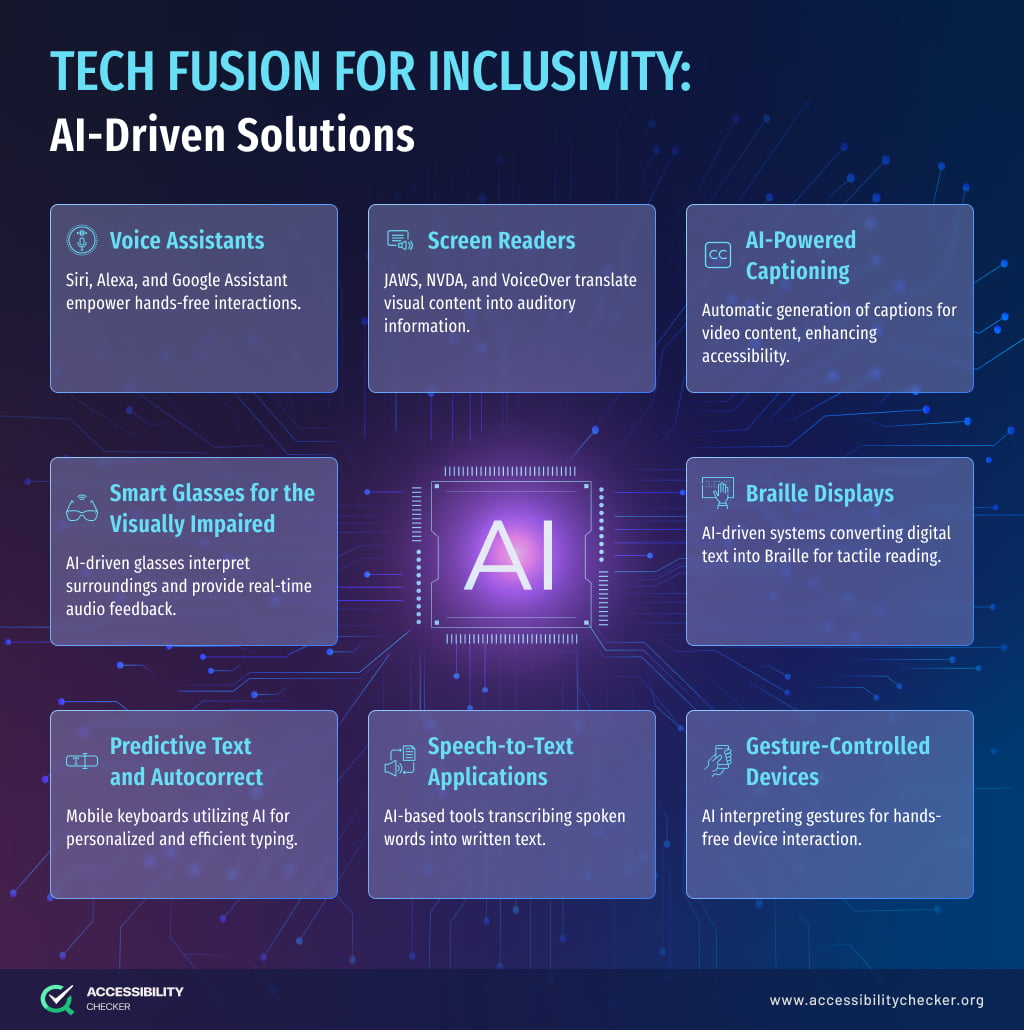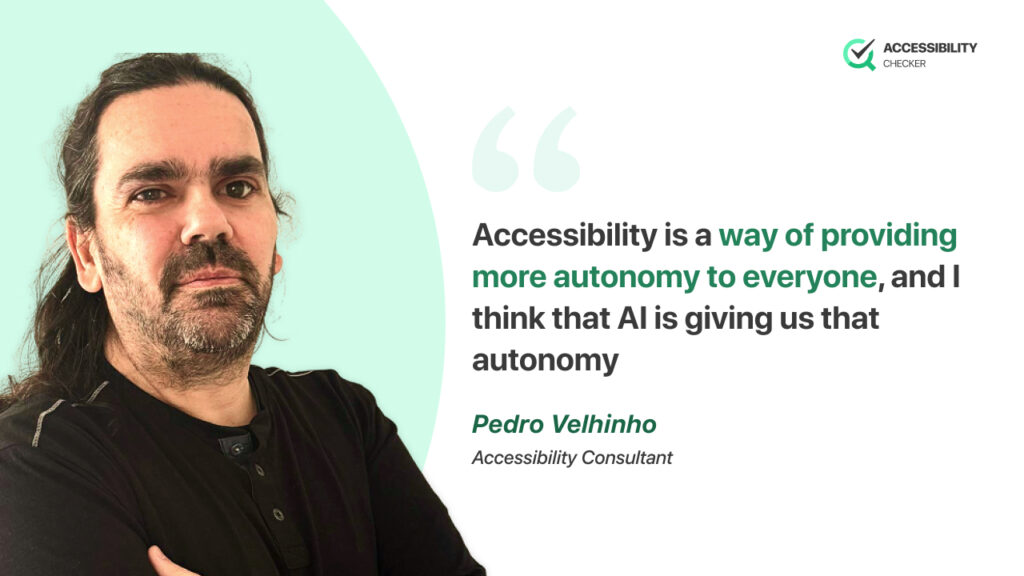accessiBe is one of the most talked-about web accessibility tools available today. It helps take a lot of the manual work out of adhering to ADA and WCAG guidelines by making it quicker and easier to identify web accessibility issues on your site.
AI for Accessibility: A Solution That Promotes Inclusivity
When technology evolves too rapidly, there’s always a risk that the disabled community will be left behind, but this is not the case with AI.
Artificial Intelligence continues to enhance a number of industries, but it is also changing the lives of people with disabilities.
When it comes to inclusivity, AI can help empower more disabled people, ensuring their lives are both convenient and fulfilling.

What is AI for Accessibility?
AI accessibility encompasses various types of technology that are designed to improve the lives of people living with disabilities.
AI accessibility technology is removing the barriers that are often present in the lives of the disabled community, creating more inclusive environments both on and offline.
Through this technology, disabled people have equal access to different services, information, and experiences, benefiting people, businesses, and society as a whole.
How Assistive AI Is Changing the Lives of People with Disabilities
Assistive AI technology is creating waves in many areas and is changing the way the disabled community views life and engages with the world around them.
Film and Television
Sitting down to watch a few episodes of your favorite series is one of the best ways to relax. Unfortunately, not everyone is able to do this because not all movies and series have audio subtitles or sign interpretation. AI is changing this.
With the help of AI assistive technology, both the blind and deaf community can enjoy some entertainment in the same way as everyone else. AI should also eventually be able to aid people with cognitive impairments and poor memory by giving them the option to ask for clarification on what they’re watching.
Web Development
Thanks to AI, it’s much easier for web developers to create quality code that is compliant with the Web Content Accessibility Guidelines (WCAG) and acts such as the ADA.
With the right prompts, tools such as Bard and ChatGPT can generate clean, accessible code that can be used to create a compliant website or app.
Education
Education is another critical area that AI is changing in all the right ways. Real-time transcriptions and captioning are enhancing the way deaf students learn and interact in the classroom. Text-to-speech assistive tools, FM listening systems, and writing support tools are some of the other types of AI-driven technology that are improving education.
Employment
Where previously it was a lot more challenging for people with disabilities to find meaningful employment, AI is ensuring they can. Along with streamlining the actual job application process, AI technology helps create work environments that are conducive to people with specific physical and mental needs. Technology simplifies many tasks through automation, which has created more jobs for people with disabilities.
Assistive Technology Development
Another way that AI is making a real difference within the disabled community is through the development of affordable assistive technology.
With the help of AI research and algorithms, developers are finding new ways to create low-cost assistive technology that caters to broader groups of people. From prosthetics to virtual assistants, assistive technology is now more readily available to everyone.
Home Life
Lastly, assistive AI technology is improving the lives of people right at home. Smart home devices are making once-challenging tasks far easier, which has been life-changing for anyone who lives alone.
People with mobility challenges can now control and automate many home functions right from a mobile device, alleviating their reliance on assistance from a third party.
Within broader communities, AI is breaking down language and speech barriers, ensuring disabled people can engage and get the help they need.

Examples of Technology That Incorporates AI and Accessibility
Let’s look at some of the AI assistive technologies that are transforming accessibility.
Image and Facial Recognition
To make it easier for people with visual impairments to interact with their environments, there is AI-recognition software. This software works with algorithms and will describe objects, scenes, and text.
The same applies to facial recognition technology. With the help of algorithms, a person who has poor vision or is blind can ask for a description of someone’s face and can even receive feedback on someone’s facial expressions and emotions.
Translation and Captioning
Natural language processing, speech recognition technology, and an audio editor are used to add captions to video content and transcribe audio content, which is essential for those with hearing impairments.
There is also technology that converts spoken language into sign language, making it possible for deaf people to communicate and engage in conversations with ease.
AI has even adapted to lip reading. Based on the movement of a person’s lips, AI will provide a text or audio version of what’s being said.
Content Comprehension
For people with cognitive disabilities who aren’t able to understand complex information, AI algorithms will summarize content and make it easier to read and comprehend. This is also an excellent tool for someone with ADHD.
Navigation
AI-powered navigation systems can provide people with mobility challenges with real-time guidance on accessible facilities near them and the best routes to take to get there. This makes unfamiliar environments a lot less daunting.
Accessibility Testing and Remediation
To ensure that business and website owners can continuously provide users and customers with an inclusive experience, there are automated AI accessibility testing and remediation tools. Instead of having to always check for compliance issues, this technology will do it automatically, saving time and helping businesses avoid costly penalties.
Accessibility Overlays
Accessibility overlays such as those from accessiBe and UserWay can be added to websites to make them more accessible to people with disabilities. These overlays provide visitors with options and features that they can use to customize their experience on a website. With the help of an accessibility overlay, users can adjust elements such as font size, color contrast, images, and text spacing.
- WCAG
- ADA
- AODA
- Section 508
- Account managers available to guide you
- 5 min installation
- 100,000+ clients use accessiBe
- Includes accessibility statement and certification
- Built specifically for websites and small and medium-sized businesses (SMBs)- some web apps might not be compatible




- WCAG
- ADA
- AODA
- Section 508
UserWay is trusted by thousands of leading brands that want to create a more inclusive experience for their online users. With the help of an easy-to-use accessibility overlay, it’s never been easier to ensure your Magento site is compliant with some of the top ADA requirements.
- Quick and easy process
- Multiple solutions and services offered
- 1M+ website installations
- Special monitoring tools for developers
- Customer support is lacking




AI to the Rescue
With AI, the accessibility possibilities are endless. As AI algorithms become more advanced, the benefits they can offer will continue to grow.
AI is speeding up the rate at which we’re able to break down the barriers that prevent the disabled community from living life to the fullest.
It’s also simplifying processes for developers, ensuring they can bring more accessible products and experiences to market much quicker.
We can’t wait to see what AI does next!




